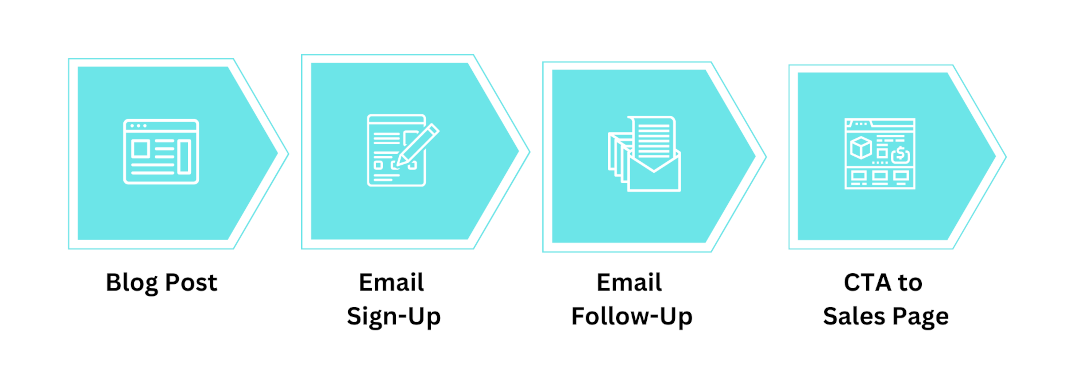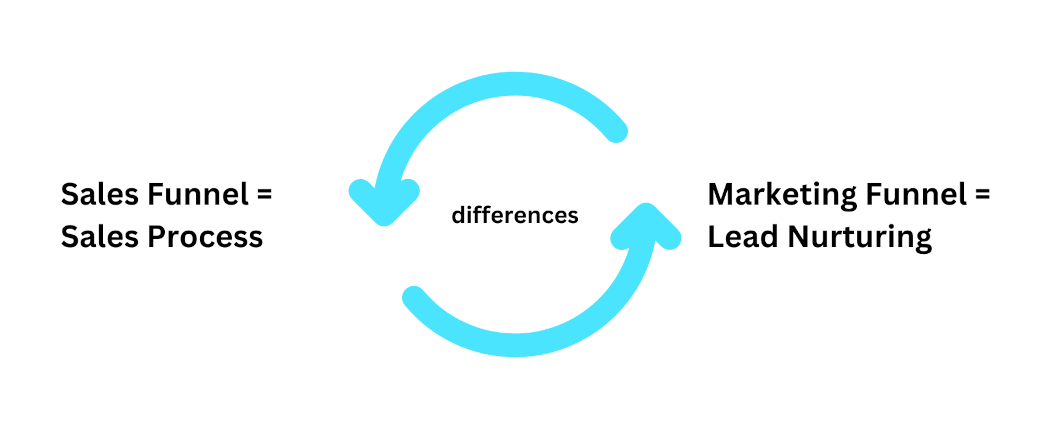Our content is reader supported, which means when you buy from links you click on, we may earn a commission.
Sales Funnel vs Marketing Funnel (Plus the Stages for Each)

Did you know that nurturing your leads inside a sales funnel can increase conversions by 47%?
Regarding sales and marketing, confusion exists around a sales funnel vs. a marketing funnel. Some people use the terms interchangeably, while others understand the differences between the two funnel types.
In this article, I will clear up the confusion once and for all. I’ll start by explaining what each term means. Then I’ll talk about the differences between them. Finally, I will discuss how automation plays a role in each type of funnel.
What Are Funnels and Why Use Them?
From a high-view perspective, a funnel helps you attract leads, move prospects through a sequence of events, and land them as customers. You do this by providing value at each step of the journey.
Conversion Rate Optimization (CRO)
CRO is a crucial part of sales and marketing funnels. It involves understanding your customers’ behavior and making data-driven decisions to optimize your website for sales conversions.
It involves optimizing everything from the design of your landing pages to the copy used in emails. You will walk prospects through the customer journey and use A/B testing to maximize sales conversions.
What Is a Marketing Funnel?
A marketing funnel is a sales process that starts with awareness and leads to conversion. The funnel aims to turn prospects into customers by providing them with valuable content, nurturing relationships, and an incentive for action.
 Top of the Funnel
Top of the Funnel
The top of your marketing funnel is the first phase and focuses on creating awareness. It involves generating interest in potential customers, capturing their contact information, and introducing them to your brand.
The top-of-the-funnel is when you educate your prospects and provide helpful content. The goal is to connect with them before you make sales offers. Several types of content marketing tactics work well during the top-of-the-funnel phase. These include:
- Blog posts
- Videos
- Social media ads
- Webinars
- Tutorials
- Influencer marketing
- ebooks
- Landing pages
Lead generation is the primary function at the top of the funnel. From a search engine optimization perspective, it’s time to write blog posts around general high-traffic keywords. You can use tutorials that teach people how to do something. People at this phase aren’t typically ready to buy a product yet.
Middle of the Funnel
The middle of the funnel is about building relationships with your prospects by providing helpful content that moves them closer to a sale. It’s also an opportunity to engage with prospects on social media and build credibility for your brand.
It involves providing more targeted and specialized content and creating a sales offer that will entice them to take action. It is a consideration stage where prospects may turn into course buyers. Or, they may seek a bit more information before making a purchase.
During the middle of the funnel phase, you are marketing to customers for repeat sales and to new leads that haven’t bought anything yet. Use webinars, email communication, social media posts, webinars, and other content. Educate and strengthen the bond between prospects and your brand.
Bottom of the Funnel
The bottom of the funnel is about closing sales and turning prospects into customers. It’s a time to make sales offers, such as special time-sensitive deals. Offer sales incentives and bonuses that will encourage them to buy from you. It’s also an opportunity to upsell your higher-end courses by offering discounts for larger purchases.
From an SEO perspective, focus on building blog posts around the bottom of the funnel keywords. These keywords include sales terms and phrases such as “buy,” “discount,” or “special deal.”
Your bottom-of-the-funnel content might include review or comparison posts depending on your market. Google searchers at the bottom of the funnel are almost done with their research. They are close to making a buying decision.
How To Use a Marketing Funnel
You will create different landing pages for your marketing funnel. These pages help lead your customers from an introduction to a sale.
For example, the first page may be an opt-in landing page. The page should have a clear call-to-action that encourages visitors to join your list. The ‘thank you’ landing page might introduce them to your course offer. Use your email service provider to continue sending follow-up information until you get a new sale. At that point, you may move them over to a ‘buyer’s list.’
Marketing Funnel Examples
Here are two marketing funnel examples to consider when selling lower-priced courses:
- Google ad – Landing page – Email list signup – Email follow-up – CTA to a sales page
- Blog post – Email signup popup – Email follow-up – CTA to a sales page

You might run the following sales funnel if you’re selling higher-ticket courses requiring a sales call.
- Facebook ad – Evergreen webinar signup – Encourage a sales call booking – Close on the sales call.
What Is a Sales Funnel?
A sales funnel is a sales process that starts with identifying leads and then moving them through a sequence of stages until they make a purchase. Using a sales funnel, you can convert potential customers into buyers by engaging with them in conversations, nurturing content, and guiding prospects down the sales path.

Marketing Qualified Leads
The first stage of the sales funnel is marketing-qualified leads (MQLs). These leads have shown interest in your business by engaging with your website, blog posts, social media content, and other online activities.
At the top of the sales funnel, your prospects can take various actions that turn them into marketing-qualified leads. These actions often involve the following:
- Signing up for email newsletters
- Downloading whitepapers or ebooks
- Visiting specific web pages
- Watching videos
- Signing up for webinars
- Filling out forms
- Investing extra time in your website
- Clicking on ads
While the above list isn’t comprehensive, it gives you an idea of how prospects can move through the sales funnel and turn into MQLs.
Sales Accepted Leads
The sales accepted lead (SAL) stage is when team members review and qualify leads. If sales personnel view the opportunity as worthwhile, they will move the prospect to the next stage of the funnel.
At this stage in the sales funnel, sales representatives need to research and find as much information as possible about the prospect before proceeding to the sales-qualified leads (SQL) stage.
Sales Qualified Leads
A lead moves into the sales-qualified lead stage after you or your sales team vets and researches them. The qualifications for turning a lead into an SQL vary from organization to organization. Some companies will only move to this stage if prospects have a particular job title, work in a specific industry, or meet other criteria.
You can use lead scoring to define when a lead becomes sales-qualified. Lead scoring is a technique used to assign numerical values to the attributes of leads so sales teams can prioritize them.
Sales representatives must establish trust and consistency with prospects at this sales funnel stage. They should provide a tailored sales pitch that outlines why their product or service is better than other alternatives on the market.
Action-Closing Deal
The sales process ends with the action-closing deal stage. This stage is where sales reps make sales offers and close deals. In this stage, sales representatives must remain persistent, patient, and persuasive to succeed.
Use sales automation techniques to speed up sales processes and increase efficiency. Automation helps salespeople automate mundane tasks such as sending follow-up emails and sales offers.
Sales Funnel Examples
A typical sales funnel might include a process where your customer takes these steps:
- Fill out a contact form on your website.
- Your sales rep reaches out to the prospect.
- The sales rep books a call with the SQL.
- The sales rep closes the sale on the call.

Another example is when you create inbound calls from your website. A website visitor clicks on your call button and talks to your salesperson. The salesperson immediately works to close your new lead into a high-ticket course customer, for instance.
Key Differences Between Marketing Funnels & Sales Funnels
When comparing the sales funnel to the marketing funnel, remember that you can use both to nurture prospects and convert them into customers. However, there are critical differences between the two.

A sales funnel takes leads through the sales process with sales activities such as sales calls, emails, sales presentations, etc. The goal is to convert prospects into sales-qualified leads (SQLs), sales-qualified opportunities (SQOs), and sales.
Inside a marketing funnel, on the other hand, you want to work on lead-nurturing activities such as content creation, email campaigns, social media posts, and more. The process builds trust with prospects to convert them into customers eventually.
How Automation Plays a Role in Marketing Funnels & Sales Funnels
Automation plays a significant role in sales funnels. Sales teams can use tools to automate repetitive tasks such as lead scoring and sales follow-ups. Another way sales teams use automation is to create sales sequences, where sales emails and calls go out automatically.
Inside a system like HubSpot, your sales team can click on the stage a client sits in to automatically send a follow-up email. Or, you might use automation to send out a thank you email immediately after a prospect makes a purchase.
You can use automation to personalize emails and content for different prospects and provide tailored sales offers inside marketing funnels. Try using automation to send personalized messages based on a prospect’s behaviors or interests.
For instance, you can use website automation tools that differentiate current email subscribers from non-leads. Offer a sales discount or specific promotion when email subscribers return to your website. If a website visitor isn’t one of your leads, offer them something of value, such as a free trial or a coupon code.